#common pill woodlouse
Photo
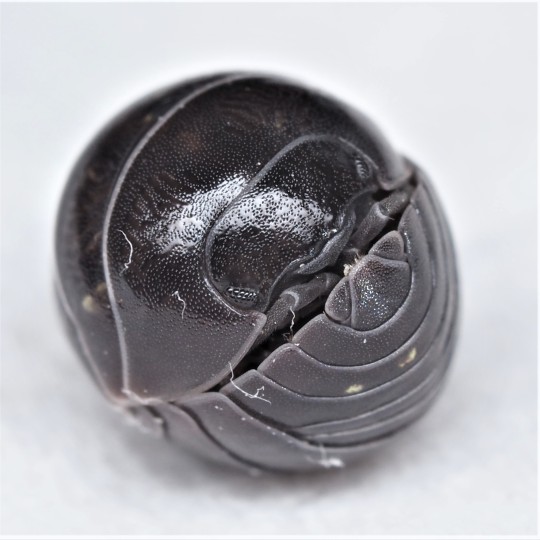

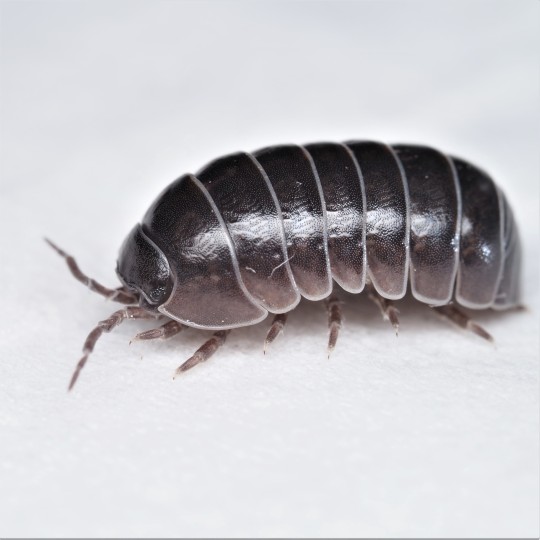
Common pill woodlouse, Armadillidium vulgare, Armadillidiidae
Native to Europe, and especially the Mediterranean basin, this species is now found throughout the world.
Photos by pfau_tarleton
#animals#curators on tumblr#bugs#crustaceans#isopod#woodlouse#pill bug#common pill woodlouse#roly poly#armadillidium#armadillidium vulgare#armadillidiidae#one nice bug
4K notes
·
View notes
Text
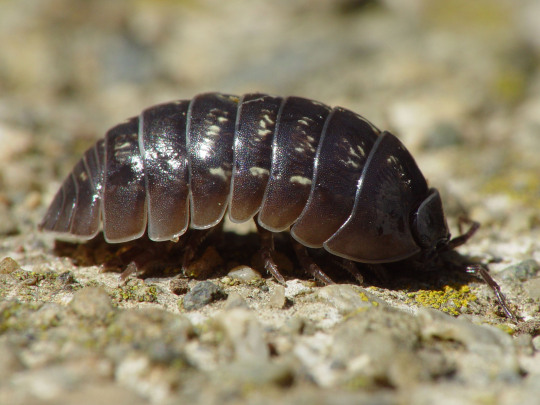
By Franco Folini - San Francisco, California, CC BY 2.5
#woodlouse#pillbug#common pill woodlouse#roly poly#isopod#crustacean#arthropod#following are for blacklist:#bug#insect
68 notes
·
View notes
Text


yay carrots
7 notes
·
View notes
Text

ITS PODZA TIME !!
#pizza tower#if i dont turn everything i like into some form of bug ill die#peppino common pill woodlouse for now if youhave a cooler isopod to suggest please do. and fake pep is just a sea slater lol#went w/ isopod because. roll into ball. fast as fuck boy#it FITS hes rolling through the tower at mach fucking speed#ball form is when u reach max speed#and 2 taunts. lol#also woodlice are just as anxious as he is. they spook so easily but are also just insane#from experience#look at them the wrong way and they scuttle away but once its feeding time its just a battlefield#girlie i promise you dont need to grab that food from the baby and kick it like a horse off the log. theres enough for both of you#slater boy taunt idea taken from bed/upo/lker a heem heem
386 notes
·
View notes
Text

Jun 16, 2023
#One of my many brickwork woodlouse sightings.#The brickwork woodlouse and the common pill woodlouse are my most frequently observed species. I see so many at work.#I shouldn't put so many on iNat but they are all so pretty...
0 notes
Text
so! we all know these lil guys right
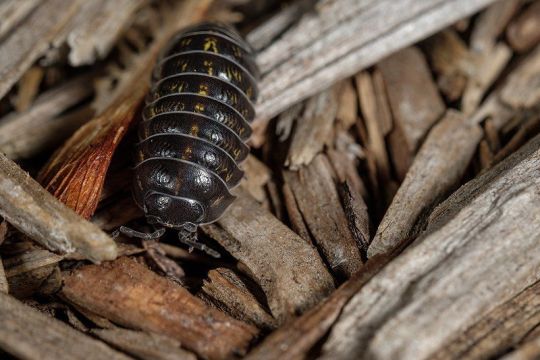

(all answers taken from my friends/me/a google search for common names)
(thank @lilyskybean for the idea ?? tyty)
413 notes
·
View notes
Text
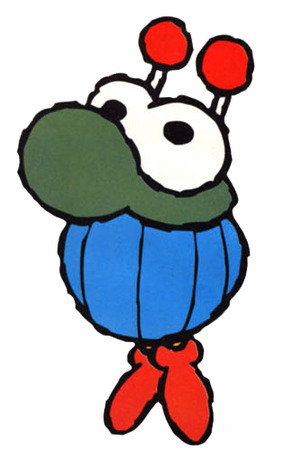
Name: Melon Bug (again)
Debut: Super Mario World 2: Yoshi’s Island
(I wanted to write some more about Melon Bug, and I liked the original post just fine, so this post will be a continuation since that one was so short!)
An isopod! Oh, joyous day! It may not look like one at all with that big ol’ nose, but when it’s rolled up, there is no mistaking it! Here’s a very fun fact: when an isopod curls into a ball, it’s called conglobation! Use that in your everyday lives.

Melon Bug technically isn’t an enemy, you know the drill, weird Mario friends, that usual thing. When curled up, Yoshi can lick them up and spit them out, defeating enemies they hit! Could this be the first instance of weaponized isopods?
The Player's Guide says "These feisty hoppers transform from bug to melon and back again." Feisty? They're only slightly more feisty than a real pill bug! And a real pill bug has a negative Feistiness Level. I don't think whoever wrote this has played the game, since Melon Bug is harmless! I also don't think they know about real pill bugs, because they clearly can't cogitate conglobation. A bug transforming into a melon? How unrealistic! What do they think this is, Trip World?
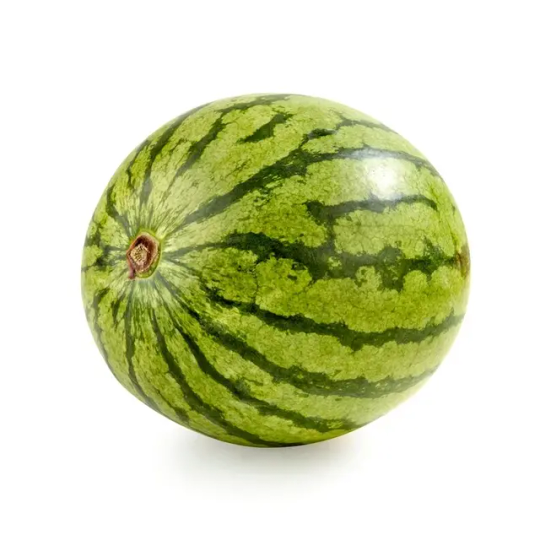
I think "Melon Bug" is a very good name. An incredible name, even! When Melon Bug curls up, it, obviously, resembles a melon, what with both being round with stripes. While real pill bugs don't really have "stripes", their tergites (armor plates) do give a "lined" appearance. If you ask me, Melon Bug could be a good name even for real terrestrial isopods!
What do YOU call pill bugs? I've always called them roly-polies, but they have so many wacky names. Woodlouse? Yeah sure, a bug that lives under wood, why not! Butchy-boy? I don't get it, but it's funny. Then there are all the names comparing them to pigs which I just do not get, but groundhogs also get compared to pigs in common names a lot, so maybe people just don't know pigs as well as they like to think. And THEN! England gave them a bunch of CHEESE-related names. What is happening over there? Are British people somehow making cheese from isopod secretions? Why would you call this creature a CHEESELOG? That's a straight up food! I kind of love this name for them for being so ridiculous! Anyway, my point with all this is that Melon Bug would be more actually fitting than the majority of the common names these have been given, but sometimes it is more fun to be unfitting!
Isn't it weird how Melon Bug's art doesn't quite look like the sprite? Such bulging eyes in the art, but little dots in-game... well, we now know the reason!

Remember Super Donkey, from the 2020 gigaleak? I feel like it's been far too forgotten for how interesting it is! Anyway, as I mentioned when talking about that game, Melon Bug was originally designed for it! It seems like the Yoshi's Island art was drawn before they decided to shrink its sclerae, and lighten its colors, but after they decided to give it little red shoes.
If you grew up calling roly-polies something else, or if you know fun names from other languages, I would love to hear them! And I hope you love and appreciate these creatures! They are so common and easy to observe, so rather than get jaded to their presence, celebrate them, and you will be able to find delight whenever you turn over a log!
#melon bug#yoshis island#super mario world 2: yoshis island#mario entities#weird mario all stars#mod chikako
146 notes
·
View notes
Text
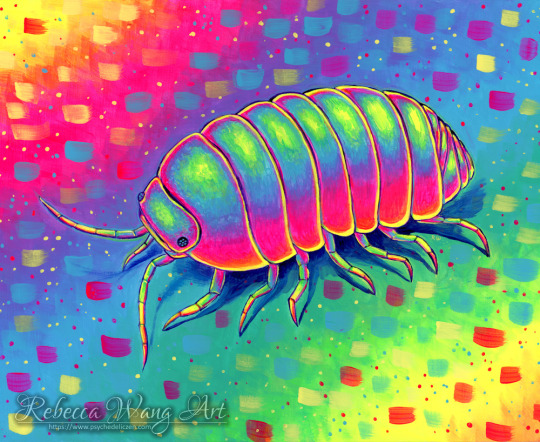
Trippy Isopod (Armadillidium vulgare)
Acrylics on 11" x 14" wood panel, November 2023.
Whether you call them an isopod, woodlouse, pill bug, potato bug, roly poly, or slater, these ubiquitous little arthropods are peaceful and underappreciated little creatures. As detritivores (eating decomposing plant matter), they are an essential part of the ecosystem. They make excellent pets and are easy to care for in captivity, provided their needs are met. They are highly gregarious and social, and the females have a strong maternal instinct and will actively protect their young. Their common name "pill-bug" refers to the fact that they can curl themselves up into a tight ball when threatened. Not all isopods have this ability.
Art Prints · Redbubble · Etsy · Facebook · Instagram
#art#artists on tumblr#traditional art#rebecca wang#psychedelic zen#acrylic painting#rainbow colors#animal art#isopod#roly poly#pill bug#armadillo bug#woodlouse#isopods#invertebrates#rolly polly#psychedelic art#Armadillidium vulgare#cw: insects
75 notes
·
View notes
Text
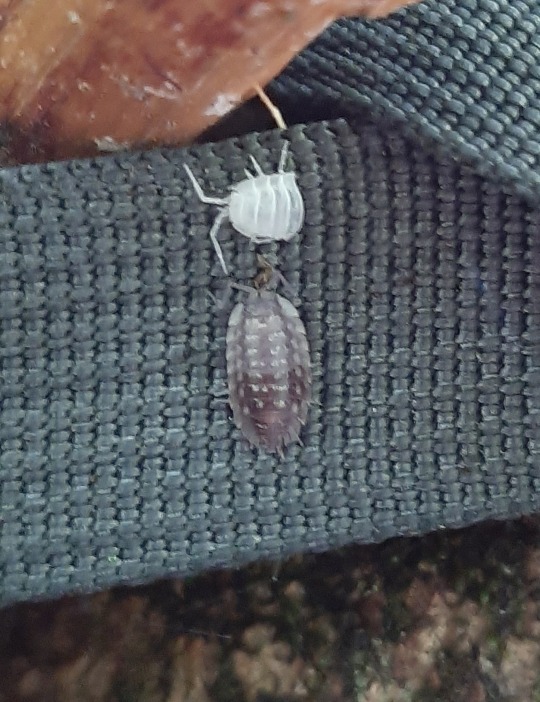
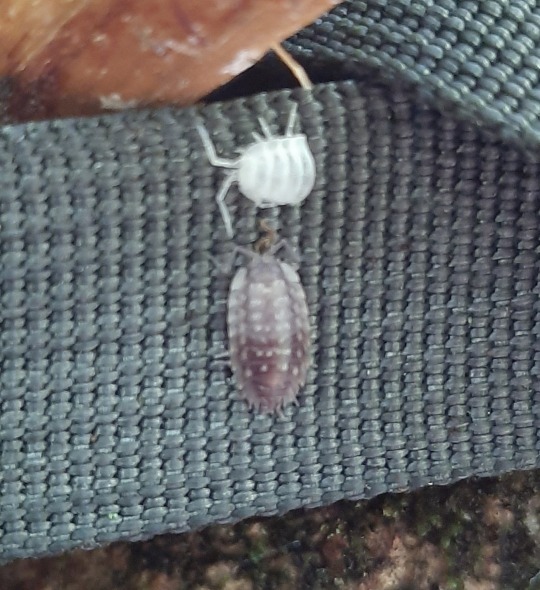
I found something very neat the other day! So this is a common shiny woodlouse, better known as a rolly polly or a pill bug. Unlike what a lot of people thing these guys aren't actually bugs, but crustations!
So why am I so excited? Well, as arthropods (which include insects, arachnids, and crustaceans) tend to do, these guys actually molt, and shed their skin! But they do it in two parts, first shedding the back half, then the front half a few days later!
I'd known this for a while but I'd never actually seen the molt intact with the antenna!
#hes on the trail cam strap!#i was so hyped i love when things like this are intact its so cool#animals#nature#critters#wild life#wildlife#animal facts#facts#arthropods#woodlouse#rolly polly#pill bug#insects#im only tagging it as that as a precaution since some people may not have other things blocked
53 notes
·
View notes
Text


@ghostieliving submitted: Sweet lil isopod friend, not completely convinced it's native to where I am I've never encountered ones that flexible before. (Chesterfield, England)
Very large and cute! Looks like a common pill woodlouse, which is native to Europe and one of the most common species in England :)
165 notes
·
View notes
Text








common pill woodlouse, Armadillidium vulgare
#the sky and clouds are reflecting off of their shell in most of these pics do you see how beautiful this planet is#my pics#bugs#isopod
31 notes
·
View notes
Text
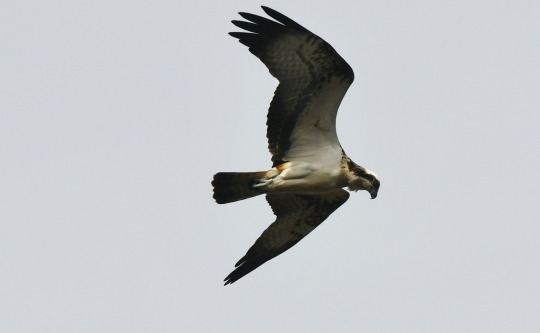
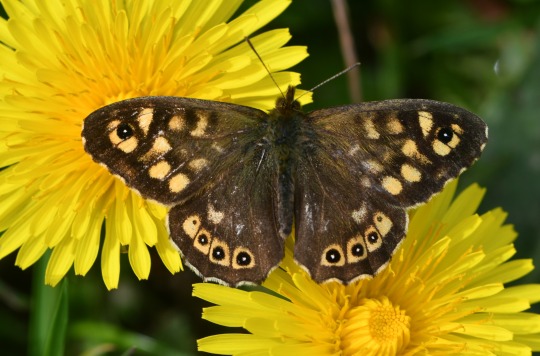
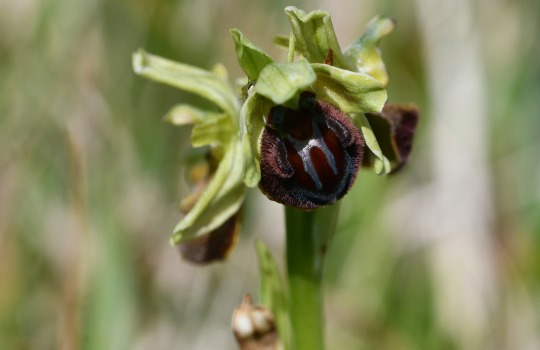

Four of my favourite photos I took in April 2024 and month summary
The photos are of; an Osprey at Lossiemouth in Moray, Speckled Wood on dandelions by Lakeside Country Park in Hampshire, early spider orchid at Durlston in Dorset and view at Laggan Dam.
April was another momentous and splendid wild month for me with so much seen and many amazing places visited. My birdwatching year continued to go from strength to strength with some smashing spring species seen and my year list kept pace with where my others had been at this stage in a year being second only to the number I was on last year my highest ever year list. Spring delights Swallow, House Martin, Wheatear, Whitethroat, glorious Sedge Warbler, Redstart, thrilling views of Guillemot and Fulmar, Little Tern and Common Tern were key species added to my year list this month alongside blockbuster names Osprey and rare Marsh Sandpiper. Avocet, Marsh Harrier, Buzzard, Sand Martin, Goldcrest, Blackcap seen and heard and my first Cuckoos heard this year were other highlights. Following the Lakeside Great Crested Grebes with their four growing chicks and a pair still courting and the new Winchester Peregrine pair was special again this month, as was seeing Greylag goslings and adorable Moorhen chicks at Lakeside. The month ended and the new one began whilst away on the incredible adventure that has been our Scotland holiday; it has been pure, tranquil, joyful and nourishing being out in wilderness areas surrounded and embraced by sensational wildlife both at the amazing cottage we’re staying in and the many fantastic places visited. By the end of April we had already seen many of the standout species of the trip including resplendent summer plumage Black-throated Diver and Red-throated Diver, majestic White-tailed Eagle, exuberant Willow Warblers a very welcome constant, Pink-footed Geese, Red Grouse, Red-legged Partridge, loads of Common Sandpipers, Little Ringed Plover, Knot, Hooded Crow, Kittiwake, amazing views of many Ospreys, Razorbill, Puffin, Common Scoter, Goosander, Goldeneye, Long-tailed Duck, Teal, Wheater, Sand Martin, Yellowhammer, Crossbill, Brambling, White Wagtail, Tree Sparrow, Raven, Skylark, Buzzard, Common Gull, Curlew, Lapwing and Oystercatcher.
It was a massive butterfly month for me too as the peak season moved through the early gears enjoying magical views of Red Admiral, Peacock, Brimstone, Speckled Wood, Small Tortoiseshell, Small White, Orange Tip, Green-veined White, Holly Blue and Wall Brown with many making the most of the wealth of dandelions out the front and at Lakeside. My moth year got going too with White-shouldered House moth at home and bright Brimstone moth at Durlston.
It was a marvellous month of mammals with Hedgehog at home, more Roe Deers in a strong year I’m having for them, Sika Deers on the way to Durlston and Grey Squirrels enjoyed. A massive part of the Scotland trip was exhilarating encounters with mammals, getting some of my best ever views of certain species; inside April this included stunning intimate views of Hares and Roe Deers around the cottage, an amazing moment as a Stoat ran through the garden, a dream encounter watching Bottlenose Dolphins at Spey Bay and Mountain Goats. Bees, spiders, Black and Yellow Cellar slugs and pill woodlouse were other highlights this moth.
Flowers gripped my month of course too as the season really matured with cuckooflower, garlic mustard, wild garlic, early purple orchid, my first ever known sighting of green-winged orchid, early spider orchid, cowslips, bluebells, greater stitchwort, marsh marigold, wood anemone, milkwort, buttercups, lesser celandine, wood anemone, cuckoo-pint, red deadnettle, white deadnettle, yellow archangel, forget-me-not, green alkanet, speedwell and herb-Robert starring alongside the breathtaking dandelion scenes. Vetch, sea and red campion, thrift, hogweed and oxeye daisy (some more than others and largely down to personal perspective) were examples of the cycle of the floral year being slightly ahead again. In Scotland it was interesting to observe spring being slightly behind compared to home with daffodils and primroses still around in numbers among others. It was nice to enjoy the sight of fungi here and there in April including hoof fungus in Scotland.
I enjoyed two great social occasions this month, the Hampshire Ornithological Society’s Member’s Day and a talk from Megan McCubbin based around her book which I thoroughly enjoyed reading earlier in the year. Both were inspirational and eye-opening times where it was great to meet like-minded people something watching the Great Crested Grebes has allowed a lot too. Finally I enjoyed being out and looking out so much in April taking in my surroundings and taking in some wonderful vistas and epic sky scenes. Immersed in the splendour of the vast, open, rugged, mountainous and varied landscape in Scotland also including wetland, coast and forest we enjoyed some incredible and breathtaking views.
#early spider orchid#durlston#dorset#laggan dam#scotland#england#osprey#speckled wood#dandelions#flowers#birdwatching#birding#bird#butterfly#birds#butterflies#great crested grebe#white-tailed eagle#red admiral#2024#april#wildlife#photography#marsh marigold#nature#reflections#europe
13 notes
·
View notes
Text
Fun fact!
A giant isopod is any of the almost 20 species of large isopods in the genus Bathynomus. They are abundant in the cold, deep waters of the Atlantic, Pacific, and Indian Oceans.[1][2] Bathynomus giganteus, the species upon which the generitype is based, is often considered the largest isopod in the world, though other comparably poorly known species of Bathynomus may reach a similar size (e.g., B. Kensleyi).[1] The giant isopods are noted for their resemblance to the much smaller common woodlouse (pill bug), to which they are related.[3]
French zoologist Alphonse Milne-Edwards was the first[4] to describe the genus in 1879[5] after his colleague Alexander Agassiz collected a juvenile male B. giganteus from the Gulf of Mexico. This was an exciting discovery for both scientists and the public, as at the time the idea of a lifeless or "azoic" deep ocean had only recently been refuted by the work of Sir Charles Wyville Thomson and others.[citation needed] No females were recovered until 1891.
Giant isopods are of little interest to most commercial fisheries, but are infamous for attacking and destroying fish caught in trawls.[6] Specimens caught in the Americas and Japan are sometimes seen in public aquariums.[3]
Giant isopods are a good example of deep-sea gigantism (cf. giant squid), as they are far larger than the "typical" isopods that are up to 5 cm (2.0 in). Bathynomus can be divided into "giant" species where the adults generally are between 8 and 15 cm (3.1 and 5.9 in) long and "supergiant" species where the adults are typically between 17 and 50 cm (6.7 and 19.7 in).[1][7] One of the "supergiants", B. giganteus, reaches a typical length between 19 and 36 cm (7.5 and 14.2 in);[4] an individual claimed to be 76 cm (30 in) long has been reported by the popular press, but the largest confirmed was c. 50 cm (20 in).[7]
Their morphology resembles that of their terrestrial relative, the woodlouse. Their bodies are dorsoventrally compressed, protected by a rigid, calcareous exoskeleton composed of overlapping segments. Like some woodlice, they can curl up into a "ball", where only the tough shell is exposed. This protects from predators trying to strike at the more vulnerable underside. The first shell segment is fused to the head; the most posterior segments are often fused, as well, forming a "caudal shield" over the shortened abdomen (pleon).[4]
The large eyes are compound with nearly 4,000 facets, sessile, and spaced far apart on the head.[8] They have two pairs of antennae. The uniramous thoracic legs or pereiopods are arranged in seven pairs, the first of which is modified into maxillipeds to manipulate and bring food to the four sets of jaws. The abdomen has five segments called pleonites, each with a pair of biramous pleopods. These are modified into swimming legs and rami, flat respiratory structures acting as gills. The isopods are a pale lilac or pinkish.[1][2]
The individual species generally resemble each other but can be separated by various morphological features, notably the number (7–13) and shape (straight or upturned) of the spines on the pleotelson ("tail"), shape (simple or bifid) of the central spine on the pleotelson, and the shape and structure of the uropods and pereopods.[1][9]
Giant isopods have been recorded in the West Atlantic from the US state of Georgia to Brazil, including the Gulf of Mexico and the Caribbean.[1] The four known Atlantic species are B. obtusus, B. miyarei, B. maxeyorum, and B. giganteus, and the last of these is the only species recorded off the United States.[1][10] The remaining Bathynomus species are all restricted to the Indo-Pacific.[1]
No species occur in both the Atlantic and Indo-Pacific. Previous records of B. giganteus from the Indo-Pacific are now considered misidentifications of other species.[1] Giant isopods are unknown from the East Atlantic or East Pacific.[1] The greatest species richness (five species) is found off eastern Australia, but it is possible other regions that are not as well-sampled match this figure.[1] In general, the distributions of giant isopods are imperfectly known, and undescribed species may exist.[1]
Giant isopods are important scavengers in the deep-sea benthic environment. They are mainly found from the gloomy sublittoral zone at a depth of 170 m (560 ft) to the pitch darkness of the bathyal zone at 2,140 m (7,020 ft), where pressures are high and temperatures are very low.[11] A few species from this genus have been reported from shallower depths, notably B. miyarei between 22 and 280 m (72 and 919 ft),[12] the poorly known B. decemspinosus between 70 and 80 m (230 and 260 ft), and B. doederleini as shallow as 100 m (330 ft).[1]
The depth record for any giant isopod is 2,500 m (8,200 ft) for B. kensleyi, but this species also occurs as shallow as 300 m (980 ft).[1] Over 80% of B. giganteus are found at a depth between 365 and 730 m (1,198 and 2,395 ft).[13] In regions with both "giant" and "supergiant" species, the former mainly live on the continental slope, while the latter mainly live on the bathyal plain.[1] Although Bathynomus have been recorded in water as warm as 20 °C (68 °F), they are primarily found in much colder places.[14] For example, during a survey of the deep-sea fauna of Exuma Sound in the Bahamas, B. giganteus was found to be common in water between 3.25 and 13 °C (37.8 and 55.4 °F), but more abundant towards the lower temperature.[15]
In contrast, preliminary studies indicate that B. doederleinii stops feeding when the temperature falls below 3 °C (37 °F).[16][17] This lower temperature limit may explain their absence from temperate and frigid regions where seas at the depth preferred by Bathynomus often are colder.[16][17] They are thought to prefer a muddy or clay substrate and lead solitary lives.
Although generalist scavengers, these isopods are mostly carnivorous and feed on dead whales, fish, and squid. They may also prey on slow-moving animals such as sea cucumbers, sponges, radiolarians, nematodes, and other zoobenthos, and perhaps even live fish. They are known to attack trawl catches. One giant isopod was filmed attacking a larger dogfish shark in a deepwater trap by latching onto and eating the its face.[18]
As food is scarce in the deep-ocean biome, giant isopods must take advantage of whatever food they have available. They are adapted to long periods of famine and have been known to survive over 5 years without food in captivity.[19][20] When a significant source of food is encountered, giant isopods gorge themselves to the point that they could barely move. A study examining the digestive system contents of 1651 specimens of B. giganteus found that fish were most commonly eaten, followed by cephalopods and decapods, particularly carideans and galatheids.[4]
Giant isopods collected along the east coast of Australia by setting traps exhibit a variation in diversity with water depth. The deeper the water, the fewer number of species found, and the larger the species tended to be. The giant isopods found in very deep waters off Australia were compared to those found off Mexico and India. From the fossil record, Bathynomus is thought to have existed more than 160 million years ago, so it did not evolve independently in all three locations, but since then Bathynomus likely would show divergent evolution in the various locations. However, the giant isopods in all three locations are almost identical in appearance[21] (although some differences are seen, and they are separate species).[1] This reduced phenotypic divergence is linked to the extremely low light levels of their habitat.[21]
A study of the seasonal abundance of B. giganteus juveniles and adults suggests a peak in reproductive capacity in the spring and winter. This is observed to be due to a shortage of food during the summer. Mature females develop a brood pouch or marsupium when sexually active, the pouch being formed by overlapping oostegites or brood plates grown from the medial border of the pereiopods. The young isopods emerge from the marsupium as miniatures of the adults, known as mancae. This is not a larval stage; the mancae are fully developed, lacking only the last pair of pereiopods.
There have been occasional attempts at utilizing giant isopods as novelty food, such as prepared in East Asian cuisine like ramen. Relative to total size, there is not very much "meat" to be harvested. The meat is sometimes described as resembling lobster and/or crab in taste, with a somewhat firmer, chewier texture.[22]
Fossilized specimens of Bathynomus are known extending back to at least the Early Oligocene (Rupelian) of Italy, with other fossils being known from Japan and Spain.[23]
4 notes
·
View notes
Text
Welp first post is gonna be my mixed colony of Isopods! Onicus asellus(common shiny woodlouse) , porcellio scaber (common rough woodlouse), porcellio spinicornis (brickwork woodlouse), armadillidum vulgare(common pill woodlouse) and I have a few orange powders and other species










3 notes
·
View notes
Text




Common Pill Bug, Armadillidium vulgare, a species of terrestrial isopods
Also known as: potato bug, common pill woodlouse, roly-poly, doodle bug, carpenter, or slater
I found this little friend while doing some yard work out front at my sister’s house. 10/10, good friend, very nice, wonderful tickling little legs, superb antennae.
8 notes
·
View notes
Text

Friend shaped
Common pill woodlouse (Armadillidium vulgare)
5 notes
·
View notes